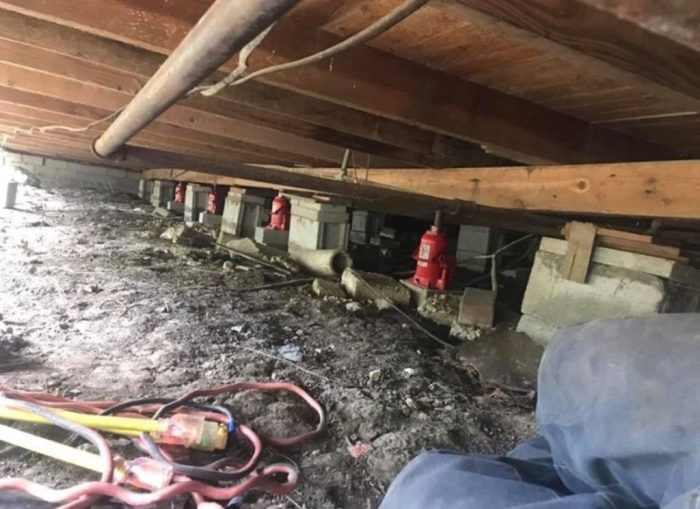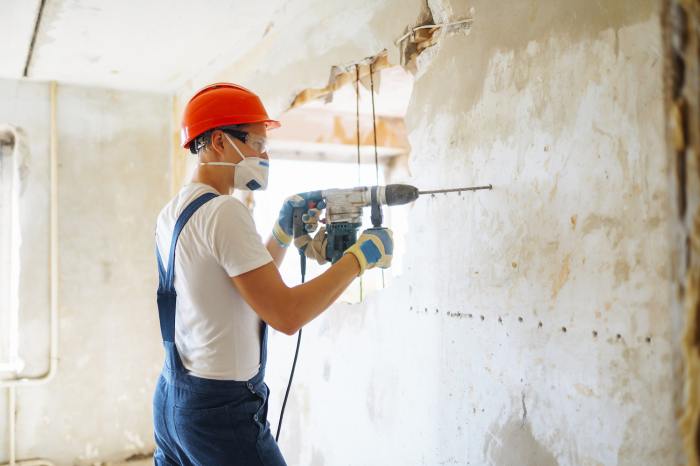DIY foundation repair takes center stage, offering homeowners the chance to tackle structural issues themselves. This guide delves into the intricacies of foundation repair, providing a comprehensive roadmap for tackling common problems. From understanding the signs of foundation damage to choosing the right materials and techniques, this resource empowers homeowners to make informed decisions about their foundation’s health.
Whether you’re dealing with cracks, settling, or other foundation issues, this guide will equip you with the knowledge and skills to approach DIY foundation repair with confidence. It’s important to remember that foundation repairs can be complex, and professional assistance may be required in certain situations. By understanding the basics of foundation repair, you can determine when DIY is feasible and when it’s best to seek expert help.
Common Mistakes to Avoid

Foundation repair is a complex process that requires careful planning and execution. While DIY foundation repair can be a cost-effective option, it’s crucial to be aware of common mistakes that can lead to further damage and costly repairs. Understanding these errors and taking precautions can help you avoid costly mistakes and ensure a successful repair.
Ignoring Warning Signs
Ignoring warning signs of foundation problems can lead to more severe damage and expensive repairs. Early detection is crucial to prevent minor issues from escalating into major problems.
- Cracks in walls or floors: Cracks in walls, floors, or ceilings can indicate foundation movement or settlement.
- Doors or windows that stick: If doors or windows are difficult to open or close, it may be a sign that the foundation is shifting.
- Uneven floors: If your floors are uneven or sloping, it could indicate foundation settlement.
- Water pooling around the foundation: Water pooling around the foundation can indicate drainage issues that can damage the foundation over time.
Maintaining a Foundation After Repair

Just like any other part of your home, a repaired foundation needs regular maintenance to prevent future problems. While a professional repair should address the root cause of the issue, ongoing care can significantly extend the lifespan of your foundation and protect your investment.
Inspecting and Maintaining a Repaired Foundation
Regular inspections are crucial to identify any potential issues early on, allowing for timely intervention before they escalate. Here are some key areas to check and how to maintain them:
- Cracks: Inspect for new cracks or widening of existing cracks. Monitor their size, location, and any changes in their appearance. Small cracks may be sealed with a high-quality sealant, while larger ones may require professional attention.
- Drainage: Ensure proper drainage around your foundation to prevent water buildup. Check gutters and downspouts for proper function and clear any debris that may obstruct water flow. Extend downspouts away from the foundation to direct water away from the structure.
- Landscaping: Avoid planting trees or shrubs too close to the foundation, as their roots can exert pressure and cause damage. Regularly prune trees and shrubs to prevent them from encroaching on the foundation.
- Grading: The ground around your foundation should slope away from the house to direct water runoff. Regrade the soil if necessary to ensure proper drainage. Avoid creating depressions near the foundation where water can accumulate.
- Foundation Walls: Check for any signs of bowing, bulging, or movement in the foundation walls. These can be early indicators of a problem that requires professional attention.
Preventative Measures for Foundation Longevity
- Regular Inspections: Schedule annual foundation inspections by a qualified professional to identify potential problems before they become major issues. This is especially important if you live in an area prone to earthquakes or other natural disasters.
- Proper Landscaping: Maintain a healthy distance between trees and shrubs and your foundation. Avoid planting trees with aggressive root systems near the foundation. Ensure that landscaping slopes away from the foundation to prevent water accumulation.
- Moisture Control: Keep the ground around your foundation dry by ensuring proper drainage. Regularly check gutters and downspouts, and repair any leaks promptly. Consider installing a dehumidifier in your basement if moisture is a concern.
- Foundation Waterproofing: If your foundation is prone to moisture problems, consider implementing waterproofing measures. This can involve applying a sealant to the exterior foundation walls or installing a drainage system to divert water away from the structure.
DIY Foundation Repair Resources

Embarking on a DIY foundation repair project requires a thorough understanding of the process and the necessary resources. It’s essential to have access to reliable information, practical guidance, and expert advice to ensure a successful and safe outcome. This section will explore various resources available for DIY foundation repair, including online platforms, books, and videos, emphasizing the importance of seeking professional guidance when needed.
Online Resources, Diy foundation repair
The internet offers a wealth of information on DIY foundation repair, providing access to various resources, including articles, forums, and video tutorials. While these resources can be helpful, it’s crucial to verify their credibility and accuracy before relying on them for your project.
- Foundation Repair Websites: Numerous websites dedicated to foundation repair provide detailed information on various foundation issues, repair techniques, and DIY tips. Examples include Foundation Repair.org, Foundation Doctor, and Foundation Repair.com. These websites often feature articles, blog posts, and FAQs addressing common foundation problems and their solutions.
- DIY Forums: Online forums dedicated to home improvement and construction provide a platform for homeowners to connect and share experiences, advice, and solutions related to foundation repair. Forums like DIY Chatroom and Homeowners Hub offer a valuable space for seeking guidance and learning from others who have undertaken similar projects.
- Video Tutorials: YouTube and other video-sharing platforms host a vast collection of DIY foundation repair tutorials. These videos can provide visual demonstrations of repair techniques, showcasing step-by-step instructions and helpful tips. However, it’s essential to choose videos from reputable sources and experienced professionals to ensure accurate information and safe practices.
Books
Books on foundation repair can offer comprehensive and detailed information on various foundation issues, repair techniques, and best practices. They often provide in-depth explanations, illustrations, and case studies, offering a more structured and comprehensive approach to understanding foundation repair.
- “Foundation Repair: A Guide to Understanding and Repairing Foundation Problems” by John A. Carmody: This book provides a comprehensive overview of foundation problems, their causes, and effective repair methods. It covers various foundation types, common issues, and step-by-step instructions for repairs, making it a valuable resource for homeowners.
- “The Complete Guide to Foundation Repair” by Richard A. Kreh: This book delves into the intricacies of foundation repair, addressing a wide range of issues, including cracks, settling, and water damage. It provides practical guidance on diagnosing problems, selecting appropriate repair techniques, and ensuring long-term stability.
Seeking Professional Advice
While DIY resources can provide valuable information, it’s crucial to understand the limitations of DIY foundation repair. Some issues may require specialized expertise and professional assessment to ensure the safety and effectiveness of the repairs. Consulting a qualified foundation repair contractor before undertaking any DIY project is highly recommended.
- Professional Assessment: A foundation repair contractor can assess the severity of the problem, identify the underlying causes, and recommend the most appropriate repair solutions. They can also provide guidance on the feasibility of DIY repairs and identify potential risks involved.
- Safety Considerations: Foundation repair often involves heavy lifting, specialized equipment, and potentially hazardous materials. Consulting a professional ensures that the repairs are carried out safely and meet building codes and regulations.
- Long-Term Durability: Professional repairs are typically designed to address the underlying causes of foundation issues, ensuring long-term stability and preventing future problems. DIY repairs, if not performed correctly, may only provide temporary solutions, leading to recurring issues.
Embarking on DIY foundation repair requires a blend of knowledge, skill, and caution. This guide provides a solid foundation for tackling common foundation problems, empowering homeowners to take control of their home’s structural integrity. Remember to prioritize safety, carefully assess the situation, and seek professional assistance when necessary. By approaching foundation repair with a thoughtful and informed mindset, homeowners can ensure the longevity and stability of their homes.
DIY foundation repair can be a daunting task, requiring careful planning and execution. While you might be tempted to tackle it yourself, it’s crucial to remember that a solid foundation is essential for your home’s structural integrity. Just like a good massage can help alleviate muscle tension, a well-maintained foundation provides stability and support. If you’re looking for tips on how to give yourself a relaxing massage, check out this helpful guide on DIY massage.
But when it comes to your foundation, it’s always best to consult with a professional to ensure the long-term health and safety of your home.
